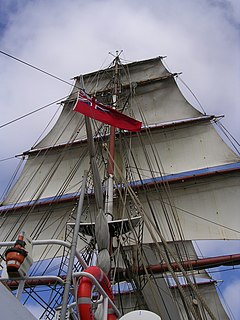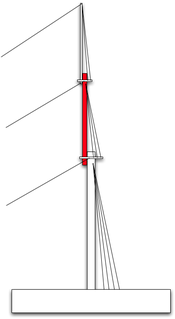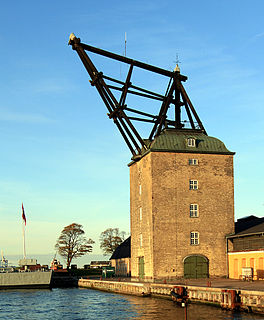
Rigging comprises the system of ropes, cables and chains, which support a sailing ship or sail boat's masts—standing rigging, including shrouds and stays—and which adjust the position of the vessel's sails and spars to which they are attached—the running rigging, including halyards, braces, sheets and vangs.

A sailing ship is a sea-going vessel that uses sails mounted on masts to harness the power of wind and propel the vessel. There is a variety of sail plans that propel sailing ships, employing square-rigged or fore-and-aft sails. Some ships carry square sails on each mast—the brig and full-rigged ship, said to be "ship-rigged" when there are three or more masts. Others carry only fore-and-aft sails on each mast, for instance some schooners. Still others employ a combination of square and fore-and-aft sails, including the barque, barquentine, and brigantine.

A sail plan is a description of the specific ways that a sailing craft is rigged. Also, the term "sail plan" is a graphic depiction of the arrangement of the sails for a given sailing craft.

A crane is a type of machine, generally equipped with a hoist rope, wire ropes or chains, and sheaves, that can be used both to lift and lower materials and to move them horizontally. It is mainly used for lifting heavy things and transporting them to other places. The device uses one or more simple machines to create mechanical advantage and thus move loads beyond the normal capability of a human. Cranes are commonly employed in transportation for the loading and unloading of freight, in construction for the movement of materials, and in manufacturing for the assembling of heavy equipment.

A hulk is a ship that is afloat, but incapable of going to sea. Hulk may be used to describe a ship that has been launched but not completed, an abandoned wreck or shell, or to refer to an old ship that has had its rigging or internal equipment removed, retaining only its buoyant qualities. The word hulk also may be used as a verb: a ship is "hulked" to convert it to a hulk. The verb was also applied to crews of Royal Navy ships in dock, who were sent to the receiving ship for accommodation, or "hulked". Hulks have a variety of uses such as housing, prisons, salvage pontoons, gambling sites, naval training, or cargo storage.

A cutter is a type of watercraft. The term has several meanings. It can apply to the rig of a sailing vessel, to a governmental enforcement agency vessel, to a type of ship's boat which can be used under sail or oars, or, historically, to a type of fast-sailing vessel introduced in the 18th century, some of which were used as small warships.

The mast of a sailing vessel is a tall spar, or arrangement of spars, erected more or less vertically on the centre-line of a ship or boat. Its purposes include carrying sails, spars, and derricks, and giving necessary height to a navigation light, look-out position, signal yard, control position, radio aerial or signal lamp. Large ships have several masts, with the size and configuration depending on the style of ship. Nearly all sailing masts are guyed.
This is a glossary of nautical terms; some remain current, while many date from the 17th to 19th centuries. See also Wiktionary's nautical terms, Category:Nautical terms, and Nautical metaphors in English. See the Further reading section for additional words and references.

A Bermuda rig, Bermudian rig, or Marconi rig is a configuration of mast and rigging for a type of sailboat and is the typical configuration for most modern sailboats. This configuration was developed in Bermuda in the 17th century; the term Marconi, a reference to the inventor of the radio, Guglielmo Marconi, became associated with this configuration in the early 20th century because the wires that stabilize the mast of a Bermuda rig reminded observers of the wires on early radio masts.

Square rig is a generic type of sail and rigging arrangement in which the primary driving sails are carried on horizontal spars which are perpendicular, or square, to the keel of the vessel and to the masts. These spars are called yards and their tips, beyond the last stay, are called the yardarms. A ship mainly rigged so is called a square-rigger.

A derrick is a lifting device composed at minimum of one guyed mast, as in a gin pole, which may be articulated over a load by adjusting its guys. Most derricks have at least two components, either a guyed mast or self-supporting tower, and a boom hinged at its base to provide articulation, as in a stiffleg derrick. The most basic type of derrick is controlled by three or four lines connected to the top of the mast, which allow it both to move laterally and cant up and down. To lift a load, a separate line runs up and over the mast with a hook on its free end, as with a crane.

The masts of traditional sailing ships were not single spars, but were constructed of separate sections or masts, each with its own rigging. The topmast is one of these.

Samson and Goliath are the twin shipbuilding gantry cranes situated at Queen's Island, Belfast, Northern Ireland. The cranes, which were named after the Biblical figures Samson and Goliath, dominate the Belfast skyline and are landmark structures of the city. Comparative newcomers to the city, the cranes rapidly came to symbolise Belfast in a way that no building or monument had hitherto done.

Kaiwo Maru is a Japanese four-masted training barque tall ship. She was built in 1989 to replace a 1930 ship of the same name. She is 110.09 m (361.2 ft) overall, with a beam of 13.80 m (45.3 ft) and a depth of 10.70 m (35.1 ft). She is assessed as 2,556 GT. Propulsion is by two 4-cylinder diesel engines and a total of 2,760 m2 (29,700 sq ft) of sails. The engines have a total power of 3,000 horsepower (2,200 kW) and can propel the ship at a maximum of 14.1 kn, with a normal service maximum of 13 kn. Kaiwo Maru has a range of 9,800 nmi. The four masts are the fore mast, main mast, mizzen mast and jigger mast. The main mast is 43.50 m (142.7 ft). Her complement is 199.

Shear legs, also known as sheers, shears, or sheer legs, are a form of two-legged lifting device. Shear legs may be permanent, formed of a solid A-frame and supports, as commonly seen on land and the floating sheerleg, or temporary, as aboard a vessel lacking a fixed crane or derrick.

Holmen is a water-bound neighbourhood in Copenhagen, Denmark, occupying the former grounds of the Royal Naval Base and Dockyards. In spite of its name, deceptively in singular, Holmen is a congregation of small islands, forming a north-eastern extension of Christianshavn between Zealand and the northern tip of Amager.

Mastekranen is an 18th-century masting sheer and present landmark on Holmen in Copenhagen, Denmark. It was designed by architect Philip de Lange and built in 1748–51 as part of the Royal Naval Shipyard at Holmen.

A block-setting crane is a form of crane. They were used for installing the large stone blocks used to build breakwaters, moles and stone piers.

The Arrol Gantry was a large steel structure built by Sir William Arrol & Co. at the Harland and Wolff shipyard in Belfast, Ireland. It was built to act as overhead cranes for the building of the three Olympic-class liners.



















